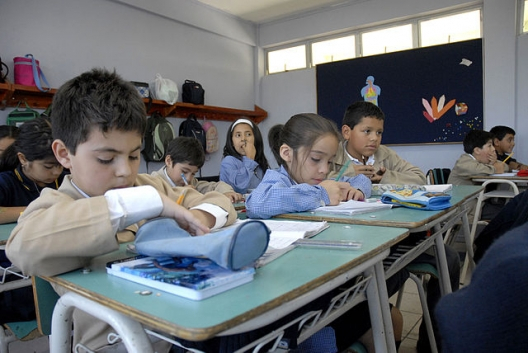 It is estimated that between now and 2040, nearly 40 percent of Latin America’s labor force will lack even a high school degree – much less, any advanced academic or professional training. This is a major challenge in a century whose economic winners are being defined by the ability to innovate, adapt, and leverage advanced human capital. Without a strong foundation in both “hard” and “soft” skills, how will the region be able to move to the next stage of development, based on technology, increased productivity, and entrepreneurship?
It is estimated that between now and 2040, nearly 40 percent of Latin America’s labor force will lack even a high school degree – much less, any advanced academic or professional training. This is a major challenge in a century whose economic winners are being defined by the ability to innovate, adapt, and leverage advanced human capital. Without a strong foundation in both “hard” and “soft” skills, how will the region be able to move to the next stage of development, based on technology, increased productivity, and entrepreneurship?
It is true that Latin America has actually improved in terms of access to education, particularly in primary school and the initial years of secondary. Unfortunately, high dropout rates mean that much of this benefit is lost on students who never get a degree. According to the World Bank, in Colombia and Chile, high school graduation rates are 60 and 70 percent, respectively. In Mexico and Argentina, that number is only 50 percent. Compounding the problem, even students that do graduate suffer from poor quality education, leaving school with achievement levels far down the ranks of comparative international evaluations.
Education reformers and experts have been focusing the debate on a number of efforts, including early childhood development, teacher training and evaluation, and other key aspects of improving our schools. But in addition to those, there is a need to refocus attention on the basic problem of the millions of students dropping out every year. Gador Manzano, who helps run the Inter-American Development Bank anti-dropout initiative GraduateXXI, argues that the failure to address this issue is not just an acute individual crisis for those who don’t finish school, but it is also a long term drag on economic growth. “The dropout crisis in Latin America demands greater attention from everyone – educators, governments, civil society, parents, and students,” he says.
Dropout rates are high for a number of reasons. Primary among these are economic pressures: many youth see little choice but to leave school and begin working in order to support themselves and their families. For them, the “opportunity cost” of continuing their education is simply too high. According to the latest report of the Latin American Educational Tendencies Information System (SITEAL in Spanish), an organization affiliated with UNESCO and the Organization of Ibero-American States (OEI), such economic considerations explain 23 percent of student dropouts.
It is not the only reason, however. According to the same report, some 40 percent of students drop out due to boredom, or because they don’t feel what they are studying is useful. And while economic pressures disproportionately impact students from lower income families, dropping out due to a lack of engagement happens at all levels of society.
Policymakers and the private sector in Latin America understand as never before the close connection between economic growth, the rise of the middle class, and rising demand for quality education. Yet the dropout crisis remains dangerously underappreciated, and there is little public discussion on how to combat it. The conversation – rightly – is focused on the diverse set of skills that will be necessary for innovation and success in the 21st century: abstract and critical thinking, teamwork and collaboration, multicultural communication, intellectual curiosity and problem solving, and an entrepreneurial attitude. But how many of these skills can we impart to students who have left school by the age of 14?
Several countries have begun to attack the problem, creating remedial education programs that offer accelerated coursework and the opportunity to take a qualifying exam. Programs like ICFES-Saber in Colombia, Ceneval in Mexico, and Adultos2000 in Buenos Aires all allow adults, most of whom are outside of the formal education system, a second chance at preparing for and passing a high school exam. Courses are given in person, online, or in some combination of the two.
Indeed, the convenience and cost-effectiveness of new education technologies makes it one of the best ways to reach those who have fallen out of the formal system and allow them to finish their secondary education. According to the SITEAL study, over five percent of dropouts cite a lack of information and access to course offerings as a primary reason. “Blended learning”, which integrated technologies into coursework, as well as online courses, offer more flexible and accessible alternatives for adults who may be working full time or whose ability to conform to a class schedule is restricted because of family obligations. These “non-traditional” approaches can also allow for the teaching of skills and job training that formal high schools do not yet offer – a significant advantage for those already in the labor force.
Yet these opportunities – flexibility, lower cost, individualization, and practicality – should also be more widely available to all students. The secondary school of the future – if it is to meet the needs of our globalized economy and engage students all the way through graduation – must look more like a dynamic combination of traditional lessons, vocational learning, and technological training. “Improving Latin America’s low education quality is not enough – we also must work to involve the half of our population that drops out back into formal education,” Manzano says. “This is our challenge.”
Gabriel Sanchez Zinny is managing director at Blue Star Strategies in Washington, DC, and rapporteur and expert adviser to the Adrienne Arsht Latin America Center’s Transatlantic Task Force on Latin America. This piece first appeared on Latinvex.
Image: Photo: Wikimedia
